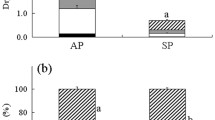Abstract
The effect of different dates of germination on the timing of flowering and the final reproductive yield was examined in a short-day annual plant Xanthium canadense (cocklebur). Delays in germination of 30 and 60 days deferred flower initiation by 2 and 9 days, respectively. Although plants that germinated later were smaller because of the shorter growing period, the reproductive yields did not show as much reduction as the vegetative biomass. The reproductive effort (RE, defined as the ratio of final reproductive yield to the vegetative biomass at the end of the growing season) increased 1.5 and 2.5 times with delays in germination of 30 and 60 days, respectively. A simple model of plant growth was used to analyse the factors involved in the control of RE, which depends only on the dry mass productivity and its partitioning in the reproductive phase, and is independent of the productivity and partitioning in the vegetative phase. Since relative allocation of dry mass to the reproductive part in the reproductive phase was similar for plants with different germination dates, the different REs could be ascribed mainly to differences in productivity of the vegetative parts in the reproductive period. The dependence of RE on plant size is discussed.
Similar content being viewed by others
References
Bazzaz FA, Carlson RW (1979) Photosynthetic contribution of flowers and seeds to reproductive effort of an annual colonizer. New Phytol 82: 223–232
Bazzaz FA, Chiariello NR, Coley PD, Pitelka LF (1987) Allocating resources to reproduction and defense. BioScience 37: 58–67
Black JN, Wilkinson GN (1963) The role of time of emergence in determining the growth of individual plants in swards of subterranean clover (Trifolium subterraneum L.) Aus J Agric Res 14: 628–638
Cohen D (1971) Maximizing final yield when growth is limited by time or by limiting resources. J Theor Biol 33: 299–307
Epstein (1972) Mineral nutrition of plants: principles and perspectives. John Wiley, New York
Eriksson O, Ehrlen J (1992) Seed and microsite limitation of recruitment in plant populations. Oecologia 91: 360–364
Esashi Y, Leopold AC (1968) Physical fores in dormancy and germination of Xanthium seeds. Plant Physiol 43: 871–876
Hara T, Kawano S, Nagai Y (1988) Optimal reproductive strategy of plants, with special reference to the modes of reproductive resource allocation. Plant Species Biol 3: 43–59
Harper JL (1977) Population biology of plants. Academic Press, New York
Harper JL, Ogden J (1970) The reproductive strategy of higher plants. I. The concept of strategy with special reference to Senecio vulgaris L. J Ecol 58: 681–698
Harper JL, Lovell PH, Moore KG (1970) The shapes and sizes of seeds. Annu Rev Ecol Syst 1: 327–356
Hickman JC (1975) Environmental unpredictability and plastic energy allocation strategies in the annual Polygonum cascadense (Polygonaceae). J Ecol 63: 689–701
Hirose T, Lambers H, Konings H, Werf A van der (1989) Modelling of respiration: effect of variation in respiration on plant growth in two Carex species. Funct Ecol 3: 655–665
Hunt R (1978) Plant growth analysis. Edward Arnold, London
Iwasa Y, Cohen D (1989) Optimal growth schedule of a perennial plant. Am Nat 133: 480–505
Kachi N, Hirose T (1983) Bolting induction in Oenothera erythrosepala Borbas in relation to rosete size, vernalization, and photoperiod. Oecologia 60: 6–9
Kawano S (1981) Trade-off relationships between some reproductive characteristics in plants with special reference to life history strategy. Bot Mag Tokyo 94: 285–294
King D, Roughgarden J (1983) Energy allocation patterns of the California grassland annuals Plantago erecta and Clarkia rubicunda. Ecology 64: 16–24
Klinkhamer PGL, Meelis E, Jong TJ de, Weiner J (1992) On the analysis of size-dependent reproductive output in plants. Funct Ecol 6: 308–316
Kozlowski J, Wiegert RG (1986) Optimal allocation of energy to growth and reproduction. Theor Pop Biol 29: 16–37
Lambers H (1985) Respiration in intact plants and tissues: Its regulation and dependence on environmental factors, metabolism and invaded organisms. In: Douce R, Day DA (eds) Higher plant cell respiration (Encyclopedia of plant physiology, NS, vol 18). Springer, Berlin Heidelberg New York, pp 418–473
Paltridge GW, Denholm JV (1974) Plant yield and the switch from vegetative to reproductive growth. J Theor Biol 44: 23–34
Reekie EG, Bazzaz FA (1987) Reproductive effort in plants. I. Carbon allocation to reproduction. Am Nat 129: 876–896
Reekie EG Bazzaz FA (1992) Cost of reproduction as reduced growth in genotypes of two congeneric species with contrasting life histories. Oecologia 90: 21–26
Salisbury FB (1981) Responses to photoperiod. In: Lange OL, Nobel PS, Osmond CB, Ziegler H (eds) Physiological plant ecology I (Encyclopedia of plant physiology, NS, Vol 12A). Springer, Berlin Heidelberg New York, pp 135–167
Schaffer WM (1977) Some observations on the evolution of reproductive rate and competitive ability in flowering plants. Theor Pop Biol 11: 90–104
Stebbins GL (1971) Adaptive radiation of reproductive characteristics in angiosperms, II: seeds and seedlings. Annu Rev Ecol Syst 2: 237–260
Sugiyama H, Hirose T (1991) Growth schedule of Xanthium canadense: Does it optimize the timing of reproduction? Oecologia 88: 55–60
Taiz L, Zeiger E (1991) Plant Physiology. Benjamin/Cummings, New York
Vincent TL, Pulliam HR (1980) Evolution of life history strategies for an asexual annual plant model. Theor Pop Biol 17: 215–231
Author information
Authors and Affiliations
Rights and permissions
About this article
Cite this article
Shitaka, Y., Hirose, T. Timing of seed germination and the reproductive effort in Xanthium canadense . Oecologia 95, 334–339 (1993). https://doi.org/10.1007/BF00320985
Received:
Accepted:
Issue Date:
DOI: https://doi.org/10.1007/BF00320985




